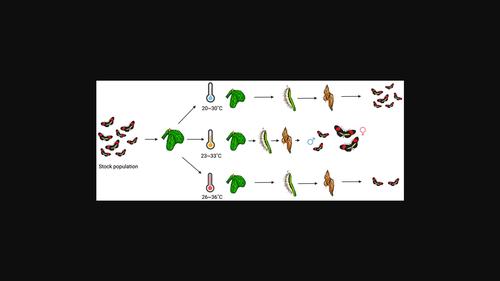当前位置:
X-MOL 学术
›
Physiol. Entomol.
›
论文详情
Our official English website, www.x-mol.net, welcomes your feedback! (Note: you will need to create a separate account there.)
Heat stress reduced survival but sped up development in Heliconius erato butterflies
Physiological Entomology ( IF 1.5 ) Pub Date : 2024-02-20 , DOI: 10.1111/phen.12431 Yuqian Huang 1 , Josie McPherson 1 , Chris D. Jiggins 1 , Gabriela Montejo‐Kovacevich 1, 2
Physiological Entomology ( IF 1.5 ) Pub Date : 2024-02-20 , DOI: 10.1111/phen.12431 Yuqian Huang 1 , Josie McPherson 1 , Chris D. Jiggins 1 , Gabriela Montejo‐Kovacevich 1, 2
Affiliation

|
Anthropogenic climate change is thought to present a significant threat to biodiversity, in particular to tropical ectotherms, and the effects of long‐term developmental heat stress on this group have received relatively little research attention. Here, we studied the effects of experimentally raising developmental temperatures on a tropical butterfly. We measured survival, development time, adult body mass and wing size of Heliconius erato demophoon (Linnaeus) (Lepidoptera: Nymphalidae) across three temperature treatments. Egg survival was lower in the hotter treatments, with 84%, 73% and 49% of eggs hatching in the 20–30°C (fluctuating temperature with 12 h at 20°C followed by 12 h at 30°C), 23–33°C and 26–36°C treatments, respectively. Larval survival was three times lower in the 26–36°C treatment (8%) compared with the 20–30°C treatment (26%), and we did not detect differences in pupal survival across treatments due to high mortality in earlier stages. Under a moderately increased temperature at 23–33°C, larvae developed faster and adults had a higher body mass and wing loading, but this was not seen in the hottest treatment (26–36°C). Females were also heavier than males in the 23–33°C treatment, but there was no associated increase in wing size. This may suggest a different developmental response to moderately elevated temperatures between the sexes. In summary, high developmental temperatures are particularly lethal for eggs and less so for larvae and also affect adult morphology. This highlights the importance of understanding the effects of temperature variation across ontogeny in tropical ectotherms.
中文翻译:

热应激降低了 Heliconiuserato 蝴蝶的存活率,但加速了发育
人为气候变化被认为对生物多样性,特别是热带变温动物构成重大威胁,而长期发育热应激对该群体的影响相对较少受到研究关注。在这里,我们研究了通过实验提高发育温度对热带蝴蝶的影响。我们测量了它们的存活率、发育时间、成年体重和翅膀大小赫里科尼埃拉托·德福丰 (林奈)(鳞翅目:蛱蝶科)跨越三种温度处理。在较热的处理中,卵的存活率较低,84%、73% 和 49% 的卵在 20–30°C 孵化(温度波动,20°C 12 小时,然后 30°C 12 小时),23–分别为 33°C 和 26–36°C 处理。与 20-30°C 处理 (26%) 相比,26-36°C 处理 (8%) 的幼虫存活率低三倍,而且由于早期死亡率较高,我们没有检测到不同处理之间蛹存活率的差异。在23-33°C适度升高的温度下,幼虫发育得更快,成虫的体重和翅膀负载更高,但在最热的处理(26-36°C)中没有看到这种情况。在 23-33°C 处理中,雌性也比雄性重,但翅膀尺寸没有相关增加。这可能表明两性对适度升高的温度有不同的发育反应。总之,高发育温度对卵尤其致命,而对幼虫则不太致命,而且还会影响成虫的形态。这凸显了了解热带变温动物个体发育过程中温度变化影响的重要性。
更新日期:2024-02-20
中文翻译:

热应激降低了 Heliconiuserato 蝴蝶的存活率,但加速了发育
人为气候变化被认为对生物多样性,特别是热带变温动物构成重大威胁,而长期发育热应激对该群体的影响相对较少受到研究关注。在这里,我们研究了通过实验提高发育温度对热带蝴蝶的影响。我们测量了它们的存活率、发育时间、成年体重和翅膀大小



























 京公网安备 11010802027423号
京公网安备 11010802027423号